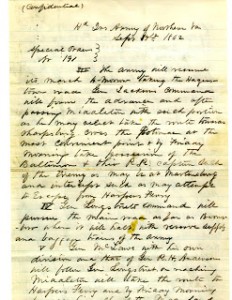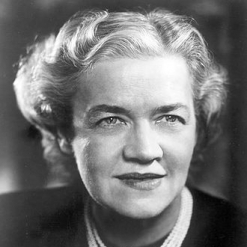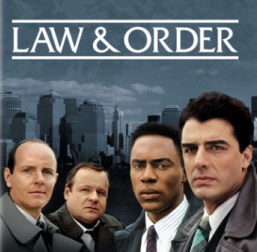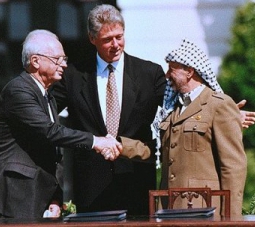On September 13…
“History is mainly a record of wars, and it has bequeathed the sorry fact that still nations devote more money to armies and navies than they do to education or the arts.”
~James Platt

1862 – Sergeant John Bloss and Corporal Barton W. Mitchell of the 27th Indiana found a piece of paper wrapped around three cigars while the division rested in a meadow outside of Frederick, Maryland, which had served as the site of a Confederate camp a few days before.
The paper was addressed to Confederate General D.H. Hill. Its title read, Special Order No. 191, Headquarters, Army of Northern Virginia. Realizing that they had discovered a copy of the Confederate operation plan, Bloss and Mitchell quickly passed it up the chain of command. Division adjutant general, Samuel Pittman recognized the handwriting on the orders as that of a colleague from the prewar army, Robert Chilton, who was the adjutant general to Robert E. Lee.
With this information, Union General George B. McClellan now knew that Lee’s forces were split into five parts and scattered over a 30-mile stretch, with the Potomac River in between. At least eight miles separated each piece of Lee’s army, and McClellan was just a dozen miles from the nearest Confederate unit at South Mountain. Civil War historian Bruce Catton has observed that “no general in the war was ever given so fair a chance to destroy the opposing army one piece at a time.”
Yet McClellan squandered the opportunity. His initial jubilation was overtaken by his caution. He believed that Lee possessed a far greater number of troops than the Confederates actually had, despite the fact that the Maryland invasion resulted in a high rate of desertion among the Southerners. McClellan was also excruciatingly slow to respond to the information in the so-called Lost Order. He took 18 hours to set his army in motion, marching toward Turner’s Gap and Crampton’s Gap in South Mountain, a 50-mile long ridge that was part of the Blue Ridge Mountains.
It is no stretch to say if McClellan had promptly acted on the discovery which had been dropped in his lap, the bloodiest day in the entire Civil War – The Battle of Antietam, just four days later – might never have happened.

1899 – Henry Bliss became the first person in the United States to be killed in an automobile accident when he was struck by an electric-powered taxicab in New York City.

1948 – Margaret Chase Smith of Maine was elected to the U.S. Senate, becoming the first woman to serve in both houses of Congress. A moderate Republican, she is perhaps best remembered for her 1950 speech, “Declaration of Conscience,” in which she criticized the tactics of McCarthyism.
Smith was an unsuccessful candidate for the Republican nomination in the 1964 presidential election, but was the first woman to be placed in nomination for the presidency at a major party’s convention.
1971 – The four-day revolt at the maximum-security Attica Correctional Facility near Buffalo, New York, ended when hundreds of state police officers stormed the complex in a hail of gunfire. Thirty-nine people were killed in the assault, including 29 prisoners and 10 prison guards and employees held hostage since the outset of the ordeal.

1990 – Law & Order premiered on NBC. It would go on to become one of the longest-running primetime dramas in TV history and spawn several popular spin-offs.

1993 – After decades of bloody animosity, representatives of Israel and Palestine met on the South Lawn of the White House and signed a framework for peace. The “Declaration of Principles” was the first agreement between the Israelis and Palestinians towards ending their conflict and sharing the holy land between the River Jordan and the Mediterranean Sea that they both claim as their homeland.

1998 – George Wallace, one of the most controversial politicians in U.S. history, died in Montgomery, Alabama, at the age of 79.
In his 1963 inaugural address, Wallace had promised his white followers: “Segregation now! Segregation tomorrow! Segregation forever!” Later that year, he was forced, under federal pressure, to end his blockade of the University of Alabama and allow the enrollment of African American students.
Despite his failures in slowing the accelerating civil rights movement in the South, Wallace became a national spokesman for resistance to racial change and in 1964 entered the race for the U.S. presidency. Although defeated in most Democratic presidential primaries he entered, his modest successes demonstrated the extent of popular backlash against integration. In 1968, he made another strong run as the candidate of the American Independent Party and managed to get on the ballot in all 50 states, drawing 10 million votes from across the country.
In 1972, Wallace returned to the Democratic Party for his third presidential campaign and, under a slightly more moderate platform, was showing promising returns when Arthur Bremer shot him on May 15. Wallace was permanently paralyzed from the waist down. He remained in the hospital for several months, bringing his third presidential campaign to an irrevocable end.

2004 – TV talk-show host Oprah Winfrey gave a brand-new Pontiac G-6 sedan, worth $28,500, to everyone in her studio audience( a total of 276 cars in all.) Oprah had told her producers to fill the crowd with people who “desperately needed” the cars, and when she announced the prize, mayhem broke out all around her. It was, as one media expert told a reporter, “one of the great promotional stunts in the history of television.”
Everybody did get a car but not everyone kept it because there was a slight catch. The tax implications, which stretched to $6,000 or more for some audience members, was a tough reality for many in the audience that day. Several “winners” took the cars, then turned around and sold them immediately, paying the required taxes and using the rest to pay off bills.

2015 – Moses Malone, a 12-time NBA All Star and an inductee in the NBA Hall of Fame, died of atherosclerotic heart disease at the age of 60.
Compiled by Ray Lemire ©2016 RayLemire.com. All Rights Reserved.